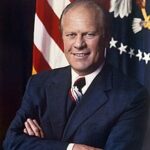President Gerald Ford’s decision to initially refuse federal assistance to financially troubled New York City became one of the most controversial urban policy decisions of the 1970s. The Ford New York City crisis reached its peak when the city faced imminent bankruptcy in October 1975.
The Financial Crisis Emerges
New York City’s fiscal troubles stemmed from decades of overspending and declining tax revenue. The city had borrowed heavily to fund social programs and infrastructure projects. By 1975, banks refused to purchase city bonds, creating a liquidity crisis. City officials warned of complete financial collapse without federal intervention. 💰 The city’s debt exceeded $13 billion, with annual budget deficits reaching dangerous levels.
Ford’s Initial Refusal
Ford argued that federal bailouts would reward fiscal irresponsibility and encourage other cities to overspend. His administration believed market forces should determine the city’s fate. The President emphasized that New York’s problems resulted from poor local management, not federal neglect. ⚠️ This stance reflected conservative economic principles about government intervention limits.
The Political Firestorm
The New York Daily News immortalized Ford’s position with the headline ‘Ford to City: Drop Dead.’ Democratic leaders accused the President of abandoning America’s largest city during its darkest hour. Urban advocates argued that New York’s collapse would trigger nationwide economic consequences. 📊 Critics pointed to the city’s importance to national commerce and culture.
Impact:
Ford’s refusal to bail out New York City created immediate political and economic consequences that reshaped American urban policy debates for decades. The decision sparked fierce opposition from Democratic leaders, urban advocates, and New York’s congressional delegation.
Immediate Political Consequences
The ‘Drop Dead’ headline became a powerful symbol of federal indifference to urban problems. Democratic presidential candidates seized on Ford’s position to attack Republican urban policies. New York’s electoral votes became virtually impossible for Ford to secure in the 1976 election. 🔥 The controversy energized Democratic voter turnout in major cities nationwide. Labor unions and civil rights groups organized protests against Ford’s urban policies.
Economic Market Reactions
Financial markets initially supported Ford’s tough stance against bailouts. However, fears of New York’s collapse began affecting national credit markets. Other cities with fiscal problems saw their borrowing costs increase significantly. 📉 Municipal bond markets experienced widespread volatility as investors questioned city creditworthiness. The crisis highlighted the interconnected nature of urban and national economies.
Policy Reversal and Long-term Effects
Ford eventually reversed course in November 1975, agreeing to federal loans with strict oversight conditions. This compromise satisfied neither conservatives nor liberals completely. The crisis established precedents for federal intervention in local fiscal emergencies. 🌍 Urban policy became a permanent fixture in presidential campaigns following this controversy. The Ford New York City standoff influenced how future administrations approached municipal financial crises, creating frameworks for federal-local cooperation during emergencies.
